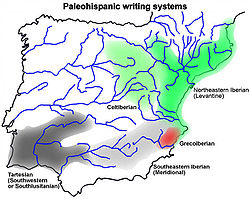Northeastern Iberian script
This article includes a improve this article by introducing more precise citations. (November 2016) |





The northeastern Iberian script, also known as Levantine Iberian or Iberian, was the main means of written expression of the Iberian language, but has also been used to write Proto-Basque as seen in the Hand of Irulegi.[1] The Iberian language is also expressed by the southeastern Iberian script and the Greco-Iberian alphabet. To understand the relationship between northeastern Iberian and southeastern Iberian scripts, one should point out that they are two different scripts with different values for the same signs. However, it is clear they have a common origin and the most accepted hypothesis is that northeastern Iberian script was derived from the southeastern Iberian script. Some researchers have concluded that it is linked to the Phoenician alphabet alone, but others believe the Greek alphabet also had a role.
Typology and variants
All the
Location of findings
The inscriptions that use the northeastern Iberian script have been found mainly in the northeastern quadrant of the
-whorls etc.), representing 95% of the total finds (over 2000 items), and nearly all the scripts were written from left to right. The oldest northeastern Iberian script date to the 4th or maybe the 5th century BCE. The modern ones date from the end of the 1st century BCE or maybe the beginning of the 1st century CE.In recent years four northeastern Iberian abecedaries or signaries have been published: the Castellet de Bernabé signary, the Tos Pelat signary, the Ger signary and the Bolvir signary, all of them belonging to the dual variant of the script.
See also
- Greco-Iberian alphabet
- Iberian scripts
- Paleohispanic scripts
- Celtiberian script
- Southeastern Iberian script
- Tartessian script
- Paleohispanic languages
- Pre-Roman peoples of the Iberian Peninsula
Notes
- ISSN 0261-3077. Retrieved 2023-06-18.
Bibliography
- Correa, José Antonio (1992): «Representación gráfica de la oposición de sonoridad en las oclusivas ibéricas (semisilabario levantino)», AION 14, pp. 253–292.
- Ferrer i Jané, Joan (2005): Novetats sobre el sistema dual de diferenciació gràfica de les oclusives sordes i sonores, Palaeohispanica 5, pp. 957–982.
- Ferrer i Jane Joan (2013): «Els sistemes duals de les escriptures ibèriques», Palaeohispanica 13, pp. 451-479.
- Gómez-Moreno, Manuel (1922): «De Epigrafia ibérica: el plomo de Alcoy», Revista de filología española 9, pp. 34–66.
- Hoz, Javier de (1985): «El nuevo plomo inscrito de Castell y el problema de las oposiciones de sonoridad en ibérico», Symbolae Ludouico Mitxelena septuagenario oblatae, pp. 443–453.
- Maluquer de Motes, Joan (1968): Epigrafía prelatina de la península ibérica, Barcelona.
- Quintanilla, Alberto (1993): «Sobre la notación en la escritura ibérica del modo de articulación de las consonantes oclusivas», Studia Palaeohispanica et Indogermánica J. Untermann ab Amicis Hispanicis Oblata, pp. 239–250.
- Rodríguez Ramos, Jesús (2004): Análisis de epigrafía íbera, Vitoria-Gasteiz.
- Untermann, Jürgen (1990): Monumenta Linguarum Hispanicarum. III Die iberischen Inschriften aus Spanien, Wiesbaden.
- Velaza, Javier (1996): Epigrafía y lengua ibéricas, Barcelona.
External links
![]() Media related to Iberian scripts at Wikimedia Commons
Media related to Iberian scripts at Wikimedia Commons
